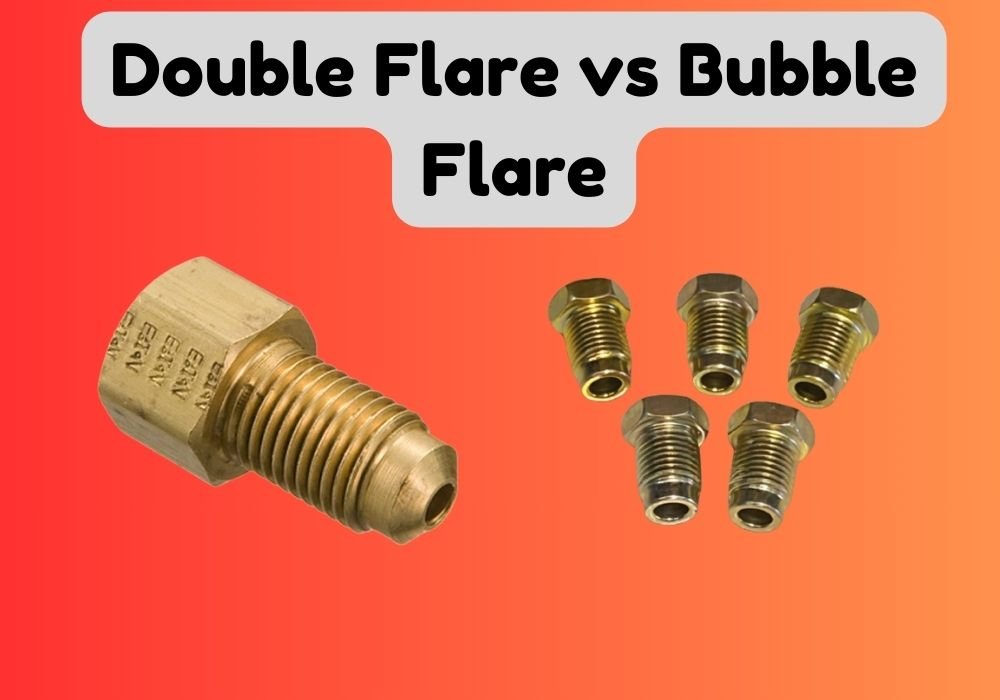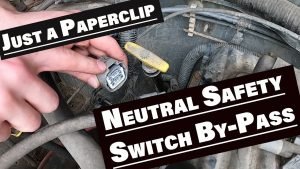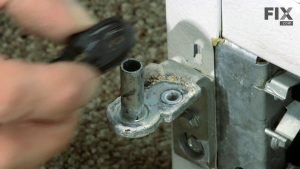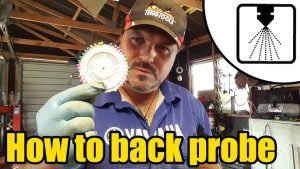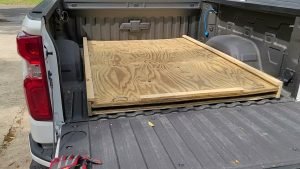When it comes to working on cars or plumbing projects, ensuring a secure and leak-free connection is paramount. One crucial aspect of achieving this reliability is choosing the right type of flare for your fittings. Flaring might sound complex, but in this guide, we’ll break it down into simple terms.
In the world of flaring, there are two popular methods: the double flare and the bubble flare. Each has its own strengths and ideal use cases, and understanding the difference between them can make all the difference in the success of your project.
In this easy-to-follow blog post, we’ll explore the basics of double flare and bubble flare. We’ll learn how they work, when to use them, and what sets them apart. By the end of this guide, you’ll have the knowledge you need to confidently select the right flare for your automotive or plumbing needs, ensuring that your connections are not just tight but safe and reliable too. So, let’s dive in and uncover the world of double flare vs. bubble flare.
Contents
Double Flare
A double flare, also known as a double inverted flare, is a type of connection used in various applications, especially in automotive and hydraulic systems where safety and durability are crucial. Let’s take a closer look at what a double flare is and why it’s used:
Definition and Purpose:
- Definition: A double flare is a specific way of forming the end of a metal tube or pipe to create a secure and leak-proof connection.
- Purpose: The main purpose of a double flare is to ensure a strong and reliable connection between two components. It’s commonly used in brake lines, fuel lines, and hydraulic systems.
How to Create a Double Flare:
- Tools Required: To make a double flare, you’ll need a few specialized tools: a flaring tool, a tube cutter, and a deburring tool.
- Step-by-Step Process:
- Cut the tubing to the desired length using a tube cutter.
- Use a deburring tool to remove any rough edges or burrs from the cut end.
- Place the tubing into the flaring tool and tighten it securely.
- Use the flaring tool to create the double flare by compressing the tubing end twice, first to form a bulge and then to fold it back onto itself.
- Ensure that the flare is smooth and free from cracks or imperfections.
Advantages of a Double Flare:
- Durability and Strength: Double flares create a robust connection that can withstand high pressure and vibration, making them ideal for critical systems like brakes.
- Leak Prevention: The double flare design provides an excellent seal, reducing the risk of fluid or gas leaks.
When to Use a Double Flare:
- You should use a double flare when working with materials like steel, stainless steel, or copper in applications where safety and reliability are paramount. This includes brake lines and fuel lines in vehicles.
A double flare is a method for creating a strong and secure connection in tubing or piping systems. It’s the go-to choice when you need a reliable and leak-free connection, especially in critical applications like automotive braking systems. Now that we understand double flares, let’s explore their counterpart, the bubble flare.
Bubble Flare
A bubble flare, sometimes referred to as a “single flare” or “ISO flare,” is another type of connection commonly used in automotive and hydraulic systems. Let’s delve into what a bubble flare is, how it’s made, and when it’s the right choice for your projects:
Definition and Purpose:
- Definition: A bubble flare is a specific method of forming the end of a metal tube or pipe to create a tight and reliable connection.
- Purpose: Bubble flares are designed to provide a secure seal without excessive pressure, making them suitable for applications like transmission lines and hydraulic systems.
How to Create a Bubble Flare:
- Tools Required: To produce a bubble flare, you’ll need a flaring tool, a tube cutter, and a deburring tool.
- Step-by-Step Process:
- Begin by cutting the tubing to the desired length using a tube cutter.
- Use a deburring tool to remove any sharp edges or burrs from the cut end.
- Insert the tubing into the flaring tool and tighten it securely.
- Use the flaring tool to form the bubble flare by gently compressing the tubing end to create a small, raised ridge or “bubble.”
- Ensure that the flare is smooth and free from any defects.
Advantages of a Bubble Flare:
- Flexibility: Bubble flares are more forgiving in terms of alignment and tube preparation, making them easier to create for beginners.
- Reduced Risk of Cracking: Bubble flares are less likely to crack or distort the tubing, which can be advantageous when working with soft materials.
When to Use a Bubble Flare:
- Bubble flares are commonly used when working with materials like steel, aluminum, or copper. They are suitable for applications where you need a secure seal without extremely high pressure, such as transmission lines and hydraulic brake systems.
A bubble flare is a method for forming a reliable and secure connection in tubing or piping systems. Its design emphasizes flexibility and ease of creation, making it a good choice for applications that don’t require the extreme strength of a double flare. Now that we understand both double flares and bubble flares, we can explore the key differences between these two important connection methods.
Key Differences Between Double Flare and Bubble Flare
Understanding the differences between a double flare and a bubble flare is essential for choosing the right connection method for your specific project. Here are the key distinctions between these two types of flares:
- Flare Shape and Appearance:
- Double Flare: A double flare has a distinctive appearance with two symmetrical folds. It resembles a “double lip” or “double ridge” at the end of the tubing.
- Bubble Flare: A bubble flare has a single fold, creating a raised ridge or “bubble” around the tubing’s edge. It appears as a single, smooth curve.
- Strength and Durability:
- Double Flare: Double flares are known for their exceptional strength and durability. They can withstand high pressure and are less prone to cracking or deformation, making them suitable for critical applications like brake lines.
- Bubble Flare: While bubble flares are strong and reliable, they may not handle as much pressure as double flares. They are better suited for applications with moderate pressure requirements.
- Applications and Scenarios:
- Double Flare: Double flares are typically used in applications where safety and leak prevention are paramount. This includes brake lines and fuel lines in vehicles.
- Bubble Flare: Bubble flares are commonly used in applications that require a secure seal without extremely high pressure. Examples include transmission lines and hydraulic systems.
- Material Compatibility:
- Double Flare: Double flares are suitable for use with a wide range of materials, including steel, stainless steel, and copper.
- Bubble Flare: Bubble flares work well with materials like steel, aluminum, and copper. They are compatible with a variety of metals but are often used with softer materials.
- Ease of Creation:
- Double Flare: Creating a double flare can be more challenging and requires precise alignment and technique. It is often considered a more advanced flaring method.
- Bubble Flare: Bubble flares are generally easier to create, making them a good choice for beginners or projects where precise alignment is challenging.
Choosing the Right Flare for Your Project
Selecting the correct flare type for your project is crucial to ensure the safety and reliability of your connections. To make an informed decision, consider the following factors:
- Material Compatibility:
- Identify the material of your tubing or pipes. Double flares and bubble flares work with various metals, but some materials are better suited for one type over the other.
- For steel, stainless steel, or copper tubing, both double and bubble flares are suitable.
- When working with softer materials like aluminum or thin-walled tubing, consider using a bubble flare due to its reduced risk of distortion.
- Pressure Requirements:
- Evaluate the pressure conditions your system will experience. Double flares are the stronger choice and should be used for high-pressure applications.
- If your project involves moderate pressure, such as transmission lines or hydraulic systems, a bubble flare may suffice.
- Application and Scenario:
- Consider the specific application and system where the flare connection will be used.
- For critical systems like brake lines and fuel lines in vehicles, where safety is paramount, opt for a double flare.
- In less critical applications like air conditioning or power steering lines, a bubble flare may be sufficient.
- Skill and Experience:
- Assess your own expertise and familiarity with flaring techniques.
- Double flares can be more challenging to create accurately and require precise alignment. If you’re a beginner or have limited experience, bubble flares are more forgiving and easier to produce.
- Consult Manuals and Guidelines:
- Refer to the manufacturer’s guidelines, service manuals, or project specifications for recommendations on the type of flare to use. These resources often provide clear instructions based on the intended application.
- Seek Professional Advice:
- When in doubt or if you’re dealing with critical systems, consider consulting a professional mechanic, plumber, or engineer with expertise in the specific field. They can offer valuable insights and guidance tailored to your project.
- Safety First:
- Prioritize safety in your decision-making process. The right flare choice can prevent leaks and potential accidents.
- Ensure that your selected flare type complies with safety standards and regulations relevant to your industry or application.
Conclusion
In the world of flaring, where connections mean the difference between safety and disaster, understanding the distinctions between double flares and bubble flares is essential. We’ve journeyed through the basics of these two critical connection methods, and now it’s time to recap what we’ve learned and underscore their significance.
Recap of Key Points:
- Double Flare: This method involves forming a tubing end with two symmetrical folds, resulting in a strong, durable, and leak-resistant connection. It shines in high-pressure applications such as brake and fuel lines, offering unparalleled reliability.
- Bubble Flare: A bubble flare, with its single fold, is a reliable choice for applications with moderate pressure requirements. It’s easier to create, more flexible, and suitable for softer materials, making it valuable in scenarios like transmission and hydraulic systems.
Selecting the Right Flare:
Choosing the right flare for your project requires careful consideration of factors such as material compatibility, pressure needs, the specific application, your skill level, and safety regulations. Always prioritize safety, and don’t hesitate to seek expert advice when in doubt.
In the world of automotive and plumbing systems, your choice of flare can be the linchpin that ensures your project’s success. Whether it’s keeping your vehicle’s brakes functioning flawlessly or maintaining the integrity of your hydraulic systems, the proper flare can’t be underestimated.
Remember that precision and attention to detail are paramount when working with flares. A well-made connection not only prevents leaks but also contributes to the overall safety and reliability of your systems.
So, as you embark on your next automotive repair or plumbing project, armed with the knowledge of double flares and bubble flares, take a moment to consider which flare type suits your needs best. By making the right choice, you’ll not only achieve a secure connection but also ensure the longevity and safety of your installations. Happy flaring!
FAQs (Frequently Asked Questions) About Double Flares and Bubble Flares
Q1: What’s the main difference between a double flare and a bubble flare?
A1: The main difference lies in their appearance and strength. A double flare has two symmetrical folds and is exceptionally strong, making it suitable for high-pressure applications like brake lines. A bubble flare, on the other hand, has a single fold, is more flexible, and is often used in applications with moderate pressure, such as transmission lines.
Q2: Can I use either flare type with any material?
A2: Both double flares and bubble flares are compatible with various metals like steel, stainless steel, and copper. However, bubble flares are a better choice for softer materials like aluminum due to their reduced risk of distortion.
Q3: Which flare type is easier to create for a beginner?
A3: Bubble flares are generally easier for beginners. They are more forgiving in terms of alignment and tube preparation. Double flares require more precision and skill.
Q4: Are double flares or bubble flares safer for automotive brake lines?
A4: Double flares are the safer choice for automotive brake lines. They offer superior strength and durability, crucial for brake systems where safety is paramount.
Q5: Can I use bubble flares for my car’s fuel lines?
A5: While bubble flares can be used for fuel lines, it’s safer to use double flares. Fuel lines can experience high pressure and vibrations, making the added strength of a double flare advantageous.
Q6: Do I need special tools to create double flares and bubble flares?
A6: Yes, you’ll need specific flaring tools for both types. These tools are designed to create the necessary shapes and ensure proper connections.
Q7: How can I prevent leaks when using double flares or bubble flares?
A7: To prevent leaks, ensure you follow the correct flaring procedures, use the appropriate tools, and check for imperfections in the flare. Tighten connections securely and inspect for any signs of leakage during and after installation.
Q8: Are there safety standards or regulations I should follow when using flares?
A8: Yes, it’s important to adhere to safety standards and regulations specific to your industry or application. Always consult relevant guidelines and consider seeking expert advice for compliance.
Q9: Can I use double flares and bubble flares interchangeably in the same system?
A9: Mixing flare types in the same system is not recommended. Stick to one type of flare for consistency and to ensure compatibility with fittings and components.
Q10: Can I reuse tubing with existing flares?
A10: Reusing tubing with existing flares is possible if the tubing is in good condition, and the flares remain intact and undamaged. However, it’s generally safer to create new flares when making connections to ensure reliability.
Affiliate Disclosure: As an Amazon Associate, I earn from qualifying purchases made through links on this site.

